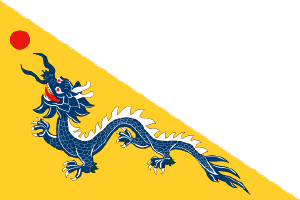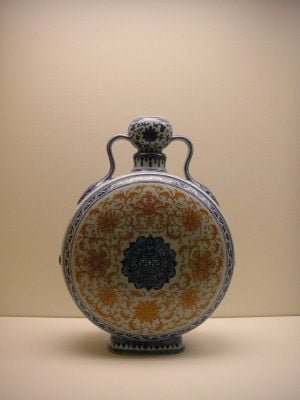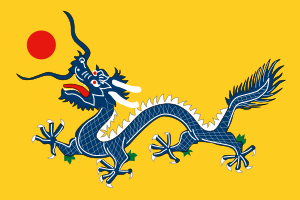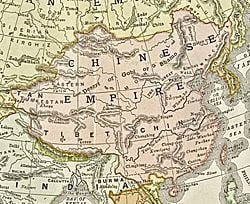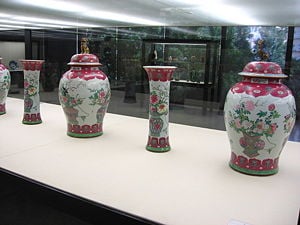Qing Dynasty
The Qing Dynasty; Manchu: daicing gurun), sometimes known as the Manchu Dynasty, was a dynasty founded by the Manchu clan Aisin Gioro, in what is today northeast China, expanded into China and the surrounding territories, establishing the Empire of the Great Qing. The Qing Dynasty was the last Imperial dynasty of China. Declared as the Later Jin Dynasty in 1616, it changed its name in 1636 to "Qing," and became the ruler of all of China in 1644, completing the Manchu conquest.
During its reign, the Qing Dynasty consolidated its grip on China, integrated with Han Chinese culture, and saw the height of Imperial Chinese influence. However, its military power weakened during the 1800s, and faced with international pressure from the European powers who were extending their imperial influence into China, massive rebellions and defeats in wars, including the Opium Wars with Great Britain the Qing Dynasty declined after the mid-ninteenth century. The Qing Dynasty was overthrown following the Xinhai Revolution when Empress Dowager Longyu, faced with massive opposition, abdicated on behalf of the last emperor, Puyi, on February 12, 1912. Internal and external factors intertwined to cause the demise of imperial China and the brith of nationalist China. European notions of sovereignty and of the nation state derived from the Westphalia Treaty of 1648, together with the influence of democratic ideals and individual rights, accompanied European imperialism. The imperial powers treated their overseas subjects and those who lived within their wider imperial domains with disdain and with little or no recognition that, unlike their subjects or citizens at home, they possessed rights. However, these people could soon read about democracy, universal values and individual and human rights in European literature. Sun Yat-sen, China's first republican President, was influenced by Abraham Lincoln's Gettysburg Address reference to government by, of and for the people. Unfortunately, the foundations for a more democratic China had not yet been built and the end of 2,000 years of imperial rule resulted in instability and fragmentation, until the communist regime was established October 1, 1949.
"Later Jin" is sometimes spelled "Later Jinn" to distinguish from another Later Jin Dynasty which ruled from 936 – 946.
Formation of the Manchu state
The Qing Dynasty was founded not by the Han Chinese, who form the majority of the Chinese population, but the Manchus, today an ethnic minority in China. Nomadic babarians, the Manchus first rose to prominence in what is now northeastern China. The Manchu state was formed by Nurhaci in the early seventeenth century. Originally a vassal under the Ming Dynasty, he declared himself Emperor of the Later Jin in 1609. In the same year, he expanded the state's economic and human resources as well as technology by enlisting the Han inhabitants of Manchuria. In 1625, Nurhaci established his capital at Shenyang (also Shenjing; Manchu: Mukden), but the following year he suffered his first major military defeat to the Ming general Yuan Chonghuan. Nurhaci died the same year. One of his most important achievements was the creation of the Eight Banner system, under which all Manchus belonged to one of the eight "Banners," which were civil as well as military units. The Banners are so-named because each division was represented by a distinctive banner.
Nurhaci's successor Huang Taiji continued to build on his father's foundations, incorporating the first Han banners into his army. Huang Taiji also adopted many Ming political institutions into his Manchu state, but also provided for Manchu domination of those institutions through a quota system. When Lingdan Khan, the last grand-Khan of the Mongols, died on his way to Tibet in 1634, his son Ejei surrendered to the Manchus and gave the great seal of the Yuan Emperor to Huang Taiji. In 1636 Huang Taiji renamed the state Qing, meaning pure, suggesting ambitions beyond Manchuria. The name Qing was chosen because the name of the preceding Ming Dynasty is composed of the characters for sun and moon, which are associated with the fire element. The Chinese character 'Qing' is comprised of the water radical and the character for blue, which are both associated with the water element. In a series of military campaigns, Huang Taiji won the submission of Inner Mongolia and Korea before proceeding to take control of the Heilongjiang region, situated around the Amur River.
Claiming the Mandate of Heaven
Beijing was sacked by a coalition of rebel forces led by Li Zicheng. The Ming Dynasty officially came to an end when the Chongzhen Emperor of China—the last Ming Emperor—committed suicide by hanging himself on a tree on Coal Hill overlooking the Forbidden City. After taking Beijing in April 1644, Li Zicheng led an army of 600,000 strong to confront Wu Sangui, the general commanding Ming's 100,000-strong garrison guarding Shanhaiguan. Shanhaiguan is the pivotal northeastern pass of the Great Wall of China located 50 miles northeast of Beijing and for years its defenses were what kept the Manchus outside of the capital. Wu, caught between two enemies, decided to cast his lot with the Manchus and made an alliance with Prince Dorgon, regent to the then six-year-old Emperor Shunzhi, son of Emperor Huang Taiji, who had died the year before.
Together, the two armies defeated Li Zicheng's rebel forces in battle on May 27, 1644. The process took another 17 years of battling Ming loyalists, pretenders and rebels. The last Ming pretender, Prince Gui, sought refuge in Burma, now modern Myanmar, but was turned over to a Qing expeditionary force headed by Wu Sangui who had him brought back to Yunnan province and executed in early 1662.
Kangxi and consolidation
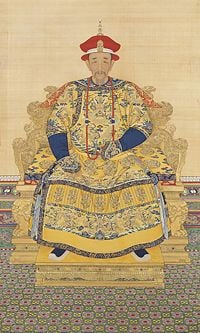
The Kangxi Emperor who ruled 1662-1722 assumed the throne at age eight. During the early years of his reign, he was largely aided by his grandmother, the Grand Empress Dowager, Xiaozhuang.
The Manchus found controlling the "Mandate of Heaven" a daunting task. The vastness of China's territory meant that there were only enough banner troops to garrison key cities forming the backbone of a defense network that relied heavily on surrendered Ming soldiers.
In addition, three surrendered Ming generals were selected for their contributions to the establishment of the Qing dynasty, ennobled as feudal princes, and given governorships over vast territories in Southern China. The chief of these was Wu Sangui, who was given the provinces of Yunnan and Guizhou, while generals Shang Kexi and Geng Zhongming were given the Guangdong and Fujian provinces, respectively.
As the years went by, the three feudal lords and their territories inevitably became increasingly autonomous. Finally, in 1673, Shang Kexi petitioned Kangxi Emperor, stating his desire to retire to his hometown in Liaodong province and nominating his son as his successor. The young emperor granted his retirement but denied the heredity of his fief. In reaction, the two other generals decided to petition for their own retirements to test Kangxi's resolve, thinking that he wouldn't risk offending them. The move backfired as the young emperor called their bluff by accepting their requests and ordering all three fiefdoms to be reverted back to the crown.
Faced with the stripping of their powers, Wu Sangui felt he had no choice but to rise up in revolt. He was joined by Geng Zhongming and by Shang Kexi's son Shang Zhixin. The ensuing rebellion lasted for eight years. At the peak of the rebels' fortunes, they managed to extend their control as far north as the river Changjiang. Ultimately, though, the Qing government was able to put down the rebellion and exert control over all of southern China. The rebellion would be known in Chinese history as the Revolt of the Three Feudatories.
To consolidate the empire, Kangxi Emperor personally led China on a series of military campaigns against Tibet, the Dzungars, and later Russia. He arranged the marriage of his daughter to the Mongol Khan Gordhun to avoid a military conflict. Gordhun's military campaign against the Qing failed, further strengthening the Empire. Taiwan was also conquered by Qing Empire forces in 1683 from Zheng Jing's son, Zheng Ke-Shuang; the former (his grandfather Koxinga) had conquered it from the Dutch colonists. By the end of the seventeenth century, China was at the height of its power since the early Ming Dynasty.
Kangxi Emperor also handled many Jesuit Missionaries that came to China hoping for mass conversions. Although they failed in their attempt, Kangxi peacefully kept the missionaries in Beijing.
The Yongzheng and Qianlong emperors
The reigns of the Yongzheng Emperor (r. 1723-1735) and his son the Qianlong Emperor (r. 1735-1796) marked the height of Qing's power. During this period, the Qing Dynasty ruled over 13 million square kilometres of territory.
After the Kangxi Emperor's death in the winter of 1722, his fourth son Prince Yong (雍親王) succeeded him as the Yongzheng Emperor. Yongzheng remained a controversial character because of rumors about him usurping the throne, and in the late Kangxi years he was involved in great political struggles with his brothers. Yongzheng was a hardworking administrator who ruled with an iron hand. His first big step towards a stronger regime came when he brought the State Examination System back to its original standards. In 1724 he cracked down on illegal exchange rates of coins, which was being manipulated by officials to fit their financial needs. Those who were found in violation of new laws on finances were removed from office, or in extreme cases, executed.
Yongzheng showed a great amount of trust in Han officials, and appointed many of his proteges to prestigious positions. Nian Gengyao was appointed to lead a military campaign in place of his brother Yinti in Qinghai. Nian's arrogant actions, however, led to his downfall in 1726. Yongzheng's reign saw consolidation of imperial power at its height in Chinese history. More territory was incorporated in the Northwest. A toughened stance was directed towards corrupt officials, and Yongzheng led the creation of a General Command Center, which grew to become the de facto Cabinet for the rest of the dynasty.
The Yongzheng Emperor died in 1735. This was followed by the succession of his son Prince Bao as the Qianlong Emperor. Qianlong was known as an able general. Succeeding the throne at the age of 24, Qianlong personally led the military in campaigns near Xinjiang and Mongolia. Revolts and uprisings in Sichuan and parts of southern China were successfully put down.
Around 40 years into Qianlong's reign, the Qing government saw a return of rampant corruption. The official Heshen was arguably one of the most corrupt in the entire Qing Dynasty. He was eventually forced into committing suicide by Qianlong's son, the Jiaqing Emperor (r. 1796 - 1820).
Rebellion, unrest and external pressure
A common view of ninteenth century China is that it was an era in which Qing control weakened and prosperity diminished. Indeed, China suffered massive social strife, economic stagnation, and explosive population growth which placed an increasing strain on the food supply. Historians offer various explanations for these events, but the basic idea is that Qing power, over the course of the century, was faced with internal problems and foreign pressure which were simply too much for the antiquated Chinese government, bureaucracy, and economy to deal with.
The Taiping Rebellion in the mid-nineteenth century was the first major instance of anti-Manchu sentiment threatening the stability of the Qing dynasty, a phenomenon that would only increase in the following years. However, the horrific number of casualties of this rebellion - as many as 30 million people—and the complete devastation of a huge area in the south of the country—have to a large extent been overshadowed by another significant conflict. Although not nearly as bloody, the outside world and its ideas and technologies had a tremendous and ultimately revolutionary impact on an increasingly weak and uncertain Qing state.
One of the major issues affecting nineteenth century China was the question of how to deal with other countries. Prior to the nineteenth century, the Chinese empire was the hegemonic power in Asia. Under its imperial theory, the Chinese emperor had the rights to rule "all under heaven." Depending on the period and dynasty, it either ruled territories directly or neighbors fell under its hierarchical tributary system. Historians often refer to the underlying concept of Chinese empire as "an empire with no boundary." However, the eighteenth century saw the European empires gradually expand across the world, as European states developed stronger economies built on maritime trade. On the other hand, the Chinese empire stagnated after centuries of being ahead of the world. By the end of the eighteenth century, European colonies had been established in nearby India and on the islands that are now part of Indonesia, while the Russian Empire had annexed the areas north of China. During the Napoleonic Wars, Great Britain attempted to forge an alliance with China, sending a fleet to Hong Kong with gifts for the Emperor, including examples of the latest European technologies and art. When the British delegation received a letter from Beijing explaining that China was unimpressed with European achievements, and that George III was welcome to pay homage to the Chinese court; the deeply offended British government aborted all further attempts to reconcile relations with the Qing regime.
When the Napoleonic Wars ended in 1815, world trade rapidly increased, and as China's vast population offered limitless markets for European goods, trade between Chinese and European merchants expanded during the early years of the nineteenth century. This increased trade, though, led to increasing hostility between European governments and the Qing regime.
In 1793, the Qing regime had officially stated that China had no use for European manufactured products. Subsequently, leading Chinese merchants only accepted bar silver as payment for their goods. The huge demand in Europe for Chinese goods including silk, tea, and ceramics could only be met if European companies funnelled their limited supplies of silver into China. By the late 1830s, the governments of Great Britain and France were deeply concerned about their stockpiles of precious metals and sought alternate trading schemes with China—the foremost of which was addicting China with opium. When the Qing regime tried to ban the opium trade in 1838, Great Britain declared war on China.
The First Opium War revealed the outdated state of the Chinese military. Although China's army overwhelmingly outnumbered the British, their technology and tactics were hopelessly inadequate for a war against the world's leading technological power. The Qing navy, composed entirely of wooden sailing junks, was no match for the steam-powered ironclad battleships of the Royal Navy. British soldiers, using modern rifles and artillery, easily outmaneuvered and outgunned Qing forces in ground battles. The Qing surrender in 1842 marked a decisive, humiliating blow to China. The Treaty of Nanking, which demanded reparation payments, allowed unrestricted European access to Chinese ports, and ceded the island of Hong Kong to Great Britain. It revealed many inadequacies in the Qing government and provoked widespread rebellions against the regime.
The Western powers, largely unsatisfied with the Treaty of Nanking, only gave grudging support to the Qing government during the Taiping and Nian Rebellions. China's income fell sharply during the wars as vast areas of farmland were destroyed, millions of lives lost, and countless armies raised and equipped to fight the rebels. In 1854, Great Britain tried to re-negotiate the Treaty of Nanking, inserting clauses allowing British commercial access to Chinese rivers and the creation of a permanent British embassy at Peking. This last clause outraged the Qing regime, who refused to sign, provoking another war with Britain. The Second Opium War ended in another crushing Chinese defeat, whilst the Treaty of Tianjin contained clauses deeply insulting to the Chinese, such as a demand that all official Chinese documents be written in English and a proviso granting British warships unlimited access to all navigable Chinese rivers.
The rule of Empress Dowager Cixi
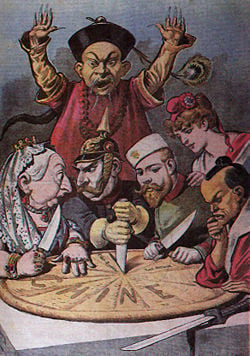
In the late nineteenth century, a new leader emerged. The Empress Dowager Cixi, concubine to the Xianfeng Emperor (r. 1850-1861), the mother of child emperor Tongzhi, and Aunt of Guangxu successfully controlled the Qing government and was the de facto leader of China for 47 years. She staged a coup d'état to oust the regency led by Sushun appointed by the late Emperor. She was known for her "behind the curtain" participation in politics.
By the 1860s, the Qing dynasty had put down the rebellions with the help of militia organized by the gentry. The Qing government then proceeded to deal with problem of modernization, which it attempted with the Self-Strengthening Movement. Several modernized armies were formed including the much renowned Beiyang Army; however the fleets of "Beiyang" were annihilated in the Sino-Japanese War (1894-1895), which produced calls for greater and more extensive reform. After the start of the twentieth century, the Qing Dynasty was in a dilemma. It could proceed with reform and thereby alienate the conservative gentry or it could stall reform and thereby alienate the revolutionaries. The Qing Dynasty tried to follow a middle path, but proceeded to alienate everyone.
Ten years into the reign of Guangxu (r. 1875 - 1908), western pressure on China was so great that she forcefully gave up all sorts of power. In 1898 Guangxu attempted the Hundred Days' Reform, in which new laws were put in place and some old rules were abolished. Newer, more progressive-minded thinkers like Kang Youwei were trusted and recognized conservative-minded people like Li Hongzhang were removed from high positions. But the ideals were stifled by Cixi and Guangxu was jailed in his own palace. Cixi, concentrated on centralizing her own power base. At the occasion of her sixtieth birthday she spent over 30 million taels of silver for the decorations and events—funds that were originally to improve the weaponry of the Beiyang Navy.
In 1901, following the murder of the German Ambassador, the Eight-Nation Alliance entered China as a united military force for the second time. Cixi reacted by declaring war on all eight nations, only to lose Beijing under their control within a short period of time. Along with the Guangxu Emperor, she fled to Xi'an. As a military compensation, the Alliance listed scores of demands on the Qing Government, including an initial hitlist which had Cixi as No. 1. Li Hongzhang was sent to negotiate and the Alliance backed down from several of the demands.
Qing government and society
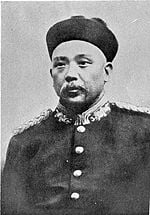
Politics
The most important administrative body of the Qing dynasty was the Grand Council which was a body composed of the emperor and high officials. The Qing dynasty was characterized by a system of dual appointments by which each position in the central government had a Manchu and a Han assigned to it. During the Qianlong Emperor's reign, for example, members of his family were distinguished by garments with a large circular emblem on the back, whereas a Han could only hope to wear clothing with a square emblem; this meant effectively that any guard in the court could immediately distinguish family members from the back view alone.
With respect to Mongolia, Tibet, and Eastern Turkestan, like other dynasties before it, the Qing maintained imperial control, with the emperor acting as Mongol khan, patron of Tibetan Buddhism and protector of Muslims. However, Qing policy changed with the establishment of Xinjiang province in 1884. In response to British and Russian military action in Xinjiang and Tibet, the Qing sent army units which performed remarkably well against British units.
The abdication of the Qing emperor inevitably led to the controversy about the status of territories in Tibet and Mongolia. It was and remains the position of Mongols and Tibetan nationalists, that because they owed allegiance to the Qing monarch, that with the abdication of the Qing, they owed no allegiance to the new Chinese state. This position was rejected by the Republic of China and subsequent People's Republic of China which based their claims on the fact that these areas were integral parts of Chinese dynasties even before the Qing. Regardless of Hans, Manchus, Mongols, or other ethnic groups, they all established Sino-centric based dynasties, and claimed their legitimacy and history as part of imperial China over the last two thousand years. The Western powers accepted the latter theory, partly in order to prevent a scramble for China.
Bureaucracy
The administrative system of the Qing Dynasty evolved out of its predecessor the Ming Dynasty. In its most-developed state, the Qing government centered around the Emperor as absolute ruler presiding over six ministries (or boards), each headed by two Supreme Secretaries (Shángshù) and assisted by four Assistant Secretaries (Shílāng). Unlike the Ming system, however, the Qing racial policy dictated that appointments were split between Manchu noblemen and Han mandarins who had passed the highest levels of the state examinations. For a large part of the Qing Dynasty, the Emperor's cabinet was represented by the Central General Command, a body initially in charge of military and intelligence matters, but which later assumed the role of overseeing all government departments. Ministers posted to the Central General Command shared the role of the Prime Minister or Chancellor, with one or several of them being designated First Minister of the Central General Command. The six ministries and their respective areas of responsibilities were as follows:
Board of Civil Appointments (Lìbú) - The personnel administration of all civil officials - including evaluation, promotion, and dismissal. It was also in charge of the 'honors list'.
Board of Finance (Húbú) - The literal translation of the Chinese word hú is 'household'. For much of the Qing Dynasty's history, the government's main source of revenue came from taxation on land ownership supplemented by official monopolies on essential household items such as salt and tea. Thus, in the predominantly agrarian Qing dynasty, the 'household' was the basis of imperial finance. The department was charged with revenue collection and the financial management of the government.
Board of Rites (Lǐbú) - This was responsible for all matters concerning protocol at court, which included not just the periodic worshipping of ancestors and various gods by the Emperor, in his capacity as the "Son of Heaven" (Tianzi), to ensure the smooth running of the empire—but also looking after the welfare of visiting ambassadors from tributary nations. The Chinese concept of courtesy (li), as taught by Confucius, was considered an integral part of education. An intellect was said to "know of books and courtesy (rites)." Thus, the ministry's other function was to oversee the nationwide civil examination system for entrance to the bureaucracy. Because democracy was unknown to pre-Republican China, neo-Confucian philosophy saw state-sponsored exams as the way to legitimize a regime by allowing the intelligentsia participation in an otherwise autocratic and unelected system.
Board of War (Bìngbú) - Unlike its Ming Dynasty predecessor, which had full control over all military matters, the Qing Dynasty Board of War had very limited powers. First, the Banner armies were under the direct control of the Emperor and hereditary Manchurian and Mongolian princes, leaving the ministry only with authority over the Green Standard armies. Furthermore, the ministry's functions were purely administrative—campaigns and troop movements were monitored and directed by the Emperor, first through the Manchu ruling council, and later through the General Command Center (Junjichu).
Board of Punishment (Xīngbú) - The Board of Punishment handled all legal matters, including the supervision of various law courts and prisons. The Qing legal framework was relatively weak in contrast to modern day legal systems, as there was no separation of executive and legislative branches of government. The legal system could be inconsistent, and, at times, arbitrary, because the emperor ruled by decree and had final say on all judicial outcomes. Emperors could (and did) overturn judgments of lower courts from time to time. Fairness of treatment was also an issue under the apartheid system practiced by the Manchu government over the Han Chinese majority. To counter these inadequacies and keep the population in line, the Qing maintained a very harsh penal code towards the Han populace, but it was no more severe than previous Chinese dynasties.
Board of Works (Gongbu) - The Board of Works handled all governmental building projects, including palaces, temples and the repairs of waterways and flood canals. It was also in charge of minting coinage.
In addition to the six boards, there was a Feudatory Affairs Office (Lǐfànyuán) unique to Qing government. This institution originated to oversee the welfare of Qing's Mongolian allies. As the empire expanded, it took over administrative responsibility of all minority ethnic groups living in and around the empire, including early contacts with Russia—then seen as a tribute nation. The office had the status of a full ministry and was headed by officials of equal rank. However, appointees were at first restricted only to candidates of Manchurian and Mongolian ethnicity.
Even though the Board of Rites and the Feudatory Affairs Office shared some duties of a foreign affairs office, they fell short of being one. This stemmed from the traditional imperial world view of seeing China as the center of the world and viewing all foreigners as uncivilized barbarians unworthy of equal diplomatic status. It was not until 1861—a year after losing the "Second Opium War" to the Anglo-French coalition—that the Qing government bowed to foreign pressure and created a proper foreign affairs office known by the cumbersome name of "Tribunal for the Management of Affairs of All Nations" (Zǒnglǐgégūoshíwú Yāmēn), or "Zǒnglǐyāmēn" (for short). The office was originally intended to be temporary and was staffed by officials seconded from the General Command Center (Jūnjīchú) on a part-time basis. However, as dealings with foreigners became increasingly complicated and frequent, the office grew in size and importance, aided by revenue from customs duties which came under its direct jurisdiction. Despite the imperial court's suspicion of all things foreign, the office became one of the most powerful departments within late Qing government.
Military
Beginnings and early development
The development of Qing military system can be divided into two broad periods separated by the Taiping rebellion (1850 - 1864). Early Qing military was rooted in the Manchu banners first developed by Nurhachi as a way to organize Manchurian society beyond petty clan affiliations. There were eight banners in all, differentiated by colors. The banners in their order of precedence were as follows: Yellow, Bordered Yellow (yellow banner with red border), White, Red, Bordered White, Bordered Red, Blue, and Bordered Blue. The Yellow, Bordered Yellow, and White banners were collectively known as the 'Upper Three Banners' and were under the direct command of the Emperor. Only Manchus belonging to the Upper Three Banners could be selected as the Emperor's personal bodyguards. The remaining banners were known as 'The Lower Five Banners' and were commanded by hereditary Manchurian princes descended from Nurhaci's immediate family, and known informally as the 'Iron Cap Princes'. Together they formed the ruling council of the Manchu nation as well as high command of the army. In 1730 Emperor Yongzheng established the General Command Center (Junjichu) at first to direct day-to-day military operations, but gradually Junjichu took over other military and administrative duties and served to centralize authority to the crown. However, the Iron Cap Princes continued to exercise considerable influence over the political and military affairs of Qing government well into the reign of Emperor Qianlong.
As Qing power expanded north of the Great Wall in the last years of the Ming dynasty, the banner system was expanded by Nurhaci's son and successor Huang Taiji to include mirrored Mongolian and Han Banners. As they controlled territories formerly under Ming rule, the relatively small Banner armies were further augmented by the Green Standard army which eventually outnumbered banner troops three-to-one. The Green Standard army so-named after the color of their battle standards was made up of those ethnic Han troops. They were led by a mix of Banner and Green Standard officers. The Banners and Green Standard troops were standing armies, paid for by central government. In addition, regional governors from provincial down to village level maintained their own irregular local militias for police duties and disaster relief. These militias were usually granted small annual stipends from regional coffers for part-time service obligations. They received very limited military drill if at all and were not considered combat troops.
Peace and stagnation
Banner Armies were divided along ethnic lines, namely Manchurian and Mongolian. Although there existed a third branch of Han bannermen made up of those who had joined the Manchus before the establishment of the Qing dynasty, Han bannermen were never regarded by the government as equal to the other two branches due to their late addition to the Manchu cause as well as their Han Chinese ancestry. The nature of their service—mainly as infantry, artillery and sappers, was also seen as alien to the Manchurian nomadic traditions of fighting as cavalry. After the conquest the military roles played by Han bannermen were quickly subsumed by the Green Standard army. The Han banners ceased to exist altogether after Emperor Yongzheng's Banner registration reforms aimed at cutting down imperial expenditures. The socio-military origins of the Banner system meant that population within each branch and their sub-divisions were hereditary and rigid. Only under special circumstances sanctioned by imperial edict were social movements between banners permitted. In contrast, the Green Standard army was originally intended to be a professional force. However during the protracted period of peace in China from the eighteenth to mid-nineteenth century, recruits from farming communities dwindled, due partly to Neo-Confucianism's negative stance on military careers. In order to maintain strengths, the Green Standard army began to internalize, and gradually became hereditary in practice.
The approximately two hundred thousand-strong Manchu Banner army was evenly divided; half was designated as the Forbidden Eight Banner Army (Jìnlǚ Bāqí) and was stationed in Beijing. It served both as the capital's garrison and Qing government's main strike force. The remainder of the Banner troops were distributed to guard key cities in China. These were known as the Territorial Eight Banner Army (Zhùfáng Bāqí). The Manchu rulers, keenly aware of their own minority status, reinforced a strict policy of racial segregation between the Manchus and Mongols from Han for fear of their being assimilated by Han. This policy applied directly to the Banner garrisons, most of which occupied a separate walled zone within the cities they were stationed at. In cities where there were limitation of space such as in Qingzhou, a new fortified town was purposely erected to house the Banner garrison and their families. Beijing being the imperial seat, the Regent Dorgon had the entire Chinese population forcibly relocated to the southern suburbs later known as the "Outer Citadel" (wàichéng). The northern walled city called "Inner Citadel" (nèichéng) was portioned out to the remaining Manchu Eight Banners, each responsible for guarding a section of the Inner Citadel surrounding the Forbidden City palace complex (Zǐjìnchéng).
The policy of posting Banner troops as territorial garrison was not to protect but to inspire awe in the subjugated populace at the expense of their expertise as cavalry. As a result, after a century of peace and lack of field training the Manchurian Banner troops had deteriorated greatly in their combat worthiness. Secondly, before the conquest the Manchu banner had been a 'citizen' army, and its members were Manchu farmers and herders obligated to provide military service to the state in times of war. The Qing government's decision to turn the Banner troops into a professional force whose every welfare and need was met by state coffers brought wealth—and with it corruption—to the rank and file of the Manchu Banners which hastened its decline as a fighting force. This was mirrored by a similar decline in the Green Standard army. In peacetime, soldiering became merely a source of supplementary income. Soldiers and commanders alike neglected training in pursuit of their own economic gains. Corruption was rampant as regional unit commanders submitted pay and supply requisitions based on exaggerated head counts to the quartermaster department and pocketed the difference. When the Taiping Rebellion broke out in 1850s, the Qing Court found out belatedly that the Banner and Green Standards troops could neither put down internal rebellions nor keep foreign invaders at bay.
Transition and modernization
Early during the Taiping Rebellion, Qing forces suffered a series of disastrous defeats culminating in the loss of the regional capital city of Nanjing in 1853. The rebels massacred the entire Manchu garrison and their families in the city and made it their capital. Shortly thereafter a Taiping expeditionary force penetrated as far north as the suburbs of Tianjin in what was considered Imperial heartlands. In desperation the court ordered a Chinese mandarin Zeng Guofan to reorganize regional and village militias (Tuányǒng and Xiāngyǒng) into a standing army to contain the Taiping rebellion. Zeng's strategy was to rely on local gentries to raise a new type of military organization from those provinces that the Taipings directly threatened. This new force became known as the Xiang Army, named after the region it was raised. Xiang Army was a hybrid of local militia and a standing army. It was given professional training, but was paid for by regional coffers and funds its commanders—mostly Chinese gentries—could muster. Xiang Army and its successor the "Huai" Army created by Zeng's colleague and 'pupil' Li Hongzhang (collectively called Yongying).
Prior to forming and commanding the Xian Army, Zeng had no military experience. Being a classically educated Mandarin his blueprint for the formation of the Xian Army was copied from a historical source—the Ming Dynasty General Qi JiGuan who, because of the weakness of the regular Ming troops, had decided to form his own 'private' army to repel raiding Japanese pirates in the mid-sixteenth century. Qi's doctrine relied heavily on Neo-Confucian ideas of binding the troops' loyalty to their immediate superiors and also to the regions which they were raised. This initially gave the troops a certain esprit de corps. However it must be pointed out that Qi's Army was an ad hoc solution for a specific problem—combating pirates, as was Zeng's original intent for the Xiang Army—to eradicate the Taiping rebels. However circumstances saw that the Yongying system became a permanent institution within the Qing military which in the long run created problems of its own for the beleagued central government.
Firstly, Yongying system signalled the end of Manchu dominance in Qing military establishment. Although the Banners and Green Standard armies lingered on depleting resources much needed by the rest of Qing administration, henceforth the Yongying corps were Qing government's de facto first-line troops. Secondly the Yongying corps were financed through provincial coffers and were led by regional commanders. This devolution of power weakened the central government's grip on the whole country, and was further aggravated by foreign powers vying to set up autonomous colonial territories in different parts of the country. However despite its negative effects the measure was deemed necessary at the time as tax revenue from rebel occupied provinces had ceased to reach the central government. Finally, the nature of Yongying command structure fostered cronyism among its commanders who—as they ascended up the bureaucratic ranks—laid the seeds to Qing's demise and the eventual outbreak of regional "warlordism."
By late 1800s China was fast descending into a semi-colonial state. Even the most conservative elements in the Qing court could no longer ignore China's military weakness in contrast to the foreign "barbarians" literally beating down its gates. In 1860 during the Second Opium War the capital Beijing was captured and the (Old) Summer Palace sacked by the relatively small Anglo-French coalition numbering 25,000. Although the Chinese pride themselves as the inventor of gunpower, and firearms had been in continual use in Chinese warfare since as far back as the Sung Dynasty, the advent of modern weaponry resulting from the Industrial Revolution in Europe such as the grooved rifle barrel (1855), Maxim gun (1885), and steam driven battleships (1890s) had rendered China's traditionally trained and equipped army and navy obsolete. Various piece-meal efforts to 'westernize' and update the weaponry of existing troops—mostly in the Haui Army yielded little lasting results. This was partly due to a lack of funds but mostly a lack of political will within the Qing government to see through measures of reform.
Losing the Sino-Japanese War of 1894-1895 was a watershed for the Qing government. Japan, a country long regarded by the Chinese as little more than an upstart nation of pirates, had convincingly beaten its larger neighbor and, in the process, annihilated the Qing government's pride and joy—its modernized Beiyang Fleet. In doing so, Japan became the first Asian country to join the previously exclusively western ranks of colonial powers. The defeat was a rude awakening to the Qing court, especially when seen in the context that it occurred a mere three decades after the Meiji reforms that had set Japan on a course to emulate the Western nations in their economic and technological achievements. Finally in December 1894 the Qing government took some concrete steps to reform military institutions and to re-train selected units in westernized drills, tactics and weaponry. These units were collectively called the New Model Army. The most successful of which was the Beiyang Army under the overall supervision and control of an ex-Huai Army commander, the Han Chinese general Yuan Shikai, who exploited his position to eventually become Republic president, dictator and finally abortive emperor of China.
Fall of the Qing dynasty
By the early twentieth century, mass civil disorder had begun and continuously grown. Cixi and the Guangxu emperor both died in 1908, leaving a relatively powerless and unstable central authority. Puyi, the eldest son of Zaifeng, Prince Chun, was appointed successor at age two, leaving Zaifeng with the regency. This was followed by the dismissal of General Yuan Shikai from his former positions of power. In mid-1911 Zaifeng created the "Imperial Family Cabinet," a ruling council of the Imperial Government almost entirely consisting of Aisin Gioro relatives. This brought a wide range of negative opinion from senior officials like Zhang Zhidong.
The Wuchang Uprising succeeded on October 10th, 1911, and was followed by a proclamation of a separate central government, the Republic of China, in Nanjing with Sun Yat-sen as its provisional head. Numerous provinces began "separating" from Qing control. Seeing a desperate situation unfold, the Qing government brought an unwilling Yuan Shikai back to military power, taking control of his Beiyang Army, with the initial goal of crushing the revolutionaries. After taking the position of Prime Minister and creating his own cabinet, Yuan went as far as to ask for the removal of Zaifeng from the regency. This removal later proceeded with directions from Empress Dowager Longyu.
With Zaifeng gone, Yuan Shi-kai and his Beiyang commanders effectively dominated Qing politics. He reasoned that going to war would be unreasonable and costly, especially when noting that the goal of the Qing Government was constitutional monarchy. Similarly, Sun Yat-sen's government wanted a Republican constitutional reform, both aiming for the benefit of China's economy and populace. With permission from Empress Dowager Longyu, Yuan began negotiating with Sun Yat-sen, who decided that his goal had been achieved in forming a republic, and that therefore he could allow Yuan to step into the position of President of the Republic. In 1912, after rounds of negotiations, Longyu issued the Imperial Edict bringing about the abdication of the child emperor Puyi.
The collapse of the Qing dynasty in 1912 brought an end to over two thousand years of imperial China and began an extended period of instability, not just at the national level but in many areas of peoples' lives. Obvious political and economic backwardness combined with widespread criticism of Chinese culture led to questioning and doubt about the future. China's turbulent history since the overthrow of the Qing may be understood at least in part as an attempt to understand and recover significant aspects of historic Chinese culture and integrate them with influential new ideas that have emerged within the last century. The Qing dynasty is the source of much of this magnificent culture, but its perceived humiliations also provide much from which to learn.
ReferencesISBN links support NWE through referral fees
- Elegant, Robert S. Manchu. New York: McGraw-Hill, 1980. ISBN 0070191638
- Fan, Fa-ti. British Naturalists in Qing China : Science, Empire, and Cultural Encounter. Cambridge, MA: Harvard University Press, 2004. ISBN 0674011430
- Spence, Jonathan D. The Search for Modern China. New York: W. W. Norton, 1999. ISBN 0393973514
- Waley-Cohen, Joanna. The Culture of War in China: Empire and the Military under the Qing Dynasty. London: I. B. Tauris, New York: Distributed in the USA by Palgrave Macmillan, 2006. ISBN 1845111591
Credits
New World Encyclopedia writers and editors rewrote and completed the Wikipedia article in accordance with New World Encyclopedia standards. This article abides by terms of the Creative Commons CC-by-sa 3.0 License (CC-by-sa), which may be used and disseminated with proper attribution. Credit is due under the terms of this license that can reference both the New World Encyclopedia contributors and the selfless volunteer contributors of the Wikimedia Foundation. To cite this article click here for a list of acceptable citing formats.The history of earlier contributions by wikipedians is accessible to researchers here:
The history of this article since it was imported to New World Encyclopedia:
Note: Some restrictions may apply to use of individual images which are separately licensed.
